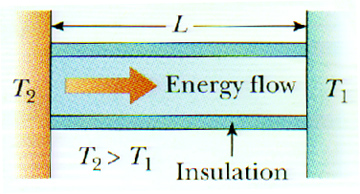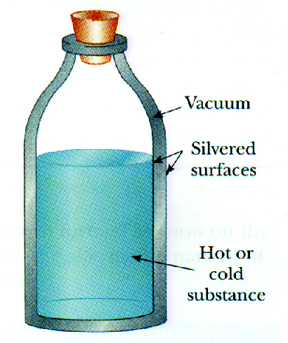

Ch20; Heat and the First Law of Thermodynamics
Energy Transfer Conduction
Hcond = heat-transfer rate for conduction
K = thermal conductivity which depends upon the material
K is large for a good heat conductor.
K is small for a good insulator.
A = cross-sectional area
L = length
T1 and T2 are the temperatures of the two regions a distance L apart.



Convection
Radiation
P =
A
T4
This is known as Stefan's law. Note the fourth power of the absolute temperature!
is a constant that depends upon the units. A is the surface area.
is the "emissivity" and depends upon the type of surface.
= 1.00 for a true "black body"; we will often use
= 1.00 as an approximation. The temperature T is the absolute temperature, of course.
= 5.6696 x 10 - 8 W / m2 K4
Thermos Bottle

Physicists and chemists and other researchers often keep liquid nitrogen and other similar cold liquids in such a container and then call it a Dewar or a Dewar flask or a Dewar container. Notice how this is constructed to minimize heat transfer by
conduction -- with the insulating vacuum
convection -- with a lid
radiation -- with silvered walls.
(c) Doug Davis, 2002; all rights reserved
Return to Ch20 ToC